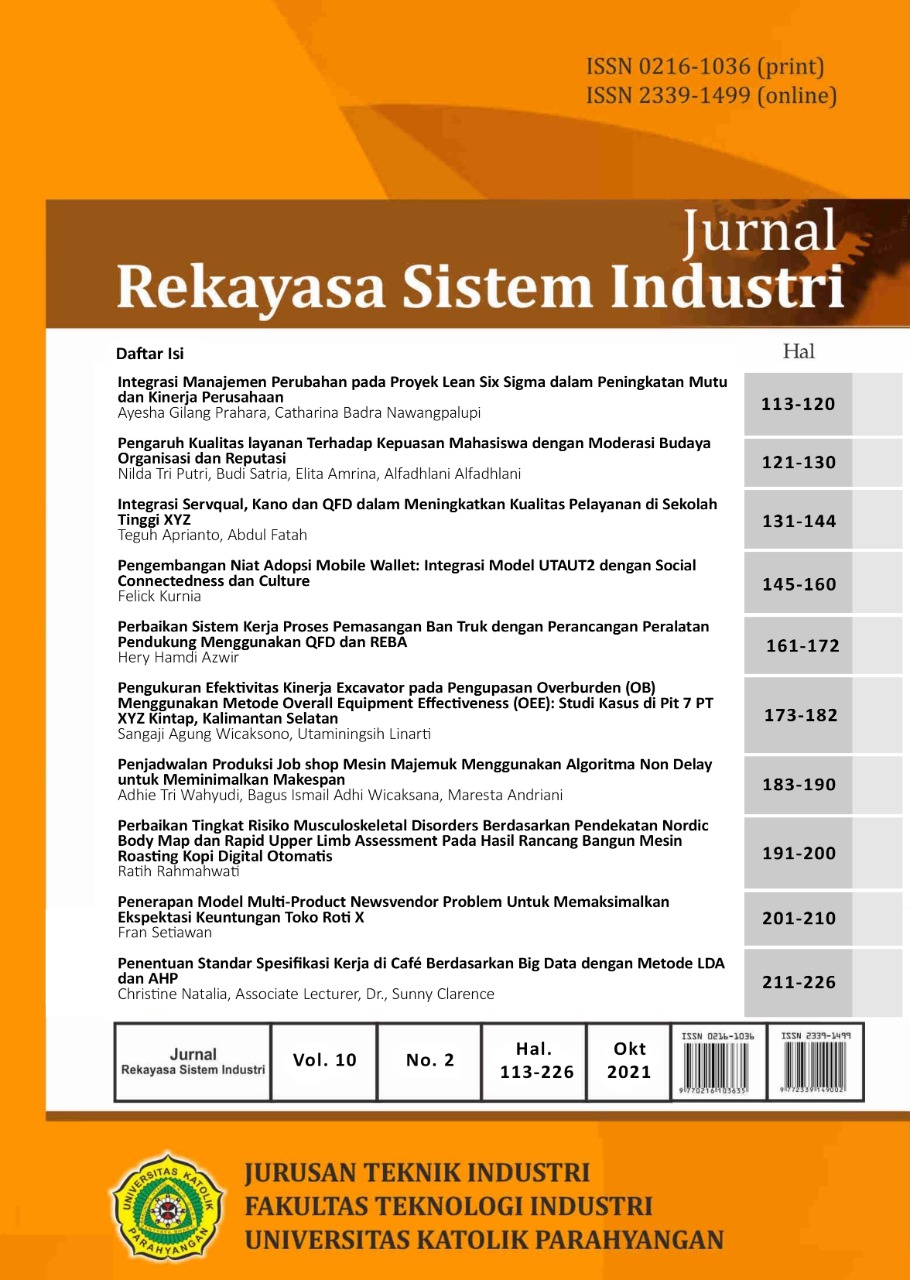Penentuan Standar Spesifikasi Kerja di Café Berdasarkan Big Data dengan Metode LDA dan AHP
DOI:
https://doi.org/10.26593/jrsi.v10i2.5228.211-226Keywords:
Big Data, Latent Dirichlet Allocation (LDA), Analytical Hierarchy Process (AHP), Food and Beverages, Sumber Daya Manusia (SDM)Abstract
A good human resources management practice will produce quality and quantity output for sustainable business. The employee recruitment process is a crucial initial stage to fulfil the needs of a quality employee. In this process, a company usually opens an advertisement for a job vacancy and selects based on job qualification requirements. This research contributes to determining job specification standards in a café or coffee shop based on Big Data analysis. Analysis has been done by Latent Dirichlet Allocation (LDA), and Analytical Hierarchy Process (AHP) method is implemented to select the type of works and work qualifications available in the food and beverages sector. Questionnaires and interviews have been conducted to collect primary data, and three leading websites of job seeker online platforms (Jobstreet.com, Gawean.id, and Lokerindonesia.com) are used as references in data collection. Finding gives information regarding four types of works in a cafe: manager, barista, chef, and waiter; eleven points for manager specifications, twelve points for barista specifications, eleven points for chef specifications, and fifteenth points for barista waiter specifications.
References
Abdullah, H. (2017 ). Peranan Manajemen Sumberdaya Manusia Dalam Organisasi. Jurnal Warta, No.51, Universitas Dharmawangsa.
Akbar, S. (2018 ). Analisa Faktor - Faktor Yang Mempengaruhi Kinerja Karyawan. Jurnal Ilmu Administrasi Negara dan Bisnis (JIAGANIS) 3(2), 1 - 17 .
Bacon, C. (1992). The use of decision criteria in selecting information systems/ technology investments. MIS Quarterly Vol. 16, No. 3, 335 - 353.
Benerjee, S., & Golhar, D. (1994). The use of decision criteria in selecting information sytems/technology investments. MIS Quarterly Vol. 16, No. 3, 335 - 353.
Catchpole, A., Middleton, C., & Nelson, T. (2001). IP telephony solutions for the customer premises . BT Technology Journal Vol. 19, No. 2, 44.
Chang, D. (1996). Applications of The Extent Analysis Method on Fuzzy AHP. European Jurnal of Operational Research, 649 - 655.
Cholissodin, I., & Riyandani, E. (2018). Analisis Big Data (Teori & Aplikasi) "Big Data vs Big Information vs Big Knowledge". Malang: Filkom.
Dahwilani, D. (2019). Data dan Fakta Tren Menjamurnya Kedai Kopi Kekinian di Indonesia. (https://www.inews.id/travel/kuliner/data-dan-fakta-tren-menjamurnya-kedai-kopi-kekinian-di-indonesia, diakses 08/06/2021)
De Mauro, A., Greco , M., Grimaldi, M., & Ritala, P. (2017). Human Resources for Big Data Professions: A Systematic Classification of Jon Roles and Required Skill Sets. Information Processing & Management. doi:DOI:10.1016/j.ipm.2017.05.004
Escobar-Perez, B. (1998). Information systems investment decisions in business practice: the spanish case. European Journal of Information Systems Vol. 7 No. 3, 202 - 209 .
Hoover, J. (2006). 5 things you must know about VoIP. Information Week , 34.
Iacovou, C., Benbasat, I., & Dexter, A. (1995). Electronic data interchange and small organizations: adoption and impact of technology. MIS Quarterly Vol. 19, No. 4, 464 - 485 .
Irani, Z. (2002). Information systems evaluation: navigating through the problem domain. Information and Management Vol. 40, No. 1, 11 - 24 .
Jones, M., & Beatty, R. (1998). Towards the development of measures of perceived benefits and compatibility of EDI: a comparative assessment of competing first order factor models. European Journal of Information Systems Vol. 7, No. 3, 210 - 220.
Kaplan , R. (1986). Must CIM be justified by faith alone? Harvard Business Review Vol. 64, No. 2, 87 - 95 .
Kominfo. (2019). Perkembangan Ekonomi Digital di Indonesia Strategi dan Sektor Potensial. Jakarta: Puslitbang Aptika dan IKP .
Kominfo. (2019, 02 19). Terkini. (https://kominfo.go.id/content/detail/16505/apa-itu-industri-40-dan-bagaimana-indonesia-menyongsongnya/0/sorotan_media , diakses dari Berita Kementerian 08/06/2021)
Kompas. (2019, 02 11). Ekonomi Bisnis. (https://ekonomi.kompas.com/read/2019/02/11/114445026/ai-iot-dan-tantangan-sektor-logistik-di-era-revolusi-industri-40?page=all , diakses dari Kompas 08/06/2021)
Microsoft. (2019). DP - 900 Microsoft Azure Data Fundamentals. Microsoft.
Mirani, R., & Lederer, A. (1998). An instrument for assessing the organizational benefits of IS projects. Decision Sciences Vol. 29, No. 4, 803 - 838.
Narendra, A. (2015 ). Data Besar, Data Analisis, dan Pengembangan Kompentensi Pustakawan . Record and Library Journal 1(2), 83 - 93.
O'callaghan, R., Kaufmann, P., & Konsynski, B. (1992). Adoption correlates and share effects of electronic data interchange systems in marketing channels. Journal of Marketing Vol. 56, 45 - 56 .
Orli, R., & Tom, J. (1987). If it's worth more than it costs, buy it! Journal of Information Systems Management Vol. 4, No. 3, 85 - 89 .
Pierce, L. (2007). The protracted enterprise migration to VoIP. Business Communications Review, Vol. 37, No. 2, 34.
Robbins , S., & Judge, T. (2014). Essentials of Organization Behavior 12th edition. New Jersey: Pearson.
Ryan , S., & Harrison , D. (2000). Considering social subsystem costs and benefits in information technology investment decisions: a view from the field on anticipated payoffs. Journal of Management Information Systems Vol. 16, No. 4, 11 - 40 .
Saaty , T. L., Peniwati, I. K., & Setiono, L. (1991). Pengambilan keputusan bagi para pemimpin : Proses hirarki analitik untuk pengambilan keputusan dalam situasi yang kompleks. Jakarta: Pustaka Binaman Pressindo.
Saaty, T. (2008). Decision Making with the Analytic Hierarchy Process. Int. J. Services Sciences , 83 - 98 .
SAS. (2021, 08 06). Big Data Insights. (https://www.sas.com/id_id/insights/big-data/what-is-big-data.html , diakses dari SAS Insights 08/06/2021)
Surbakti, F. P. S. (2020). What is Effective Use of Big Data? The Consensual Definition of Effective Use of Big Data. Paper presented at the IOP Conference Series: Materials Science and Engineering.
Syelviani , M. (2017 ). Pengaruh Deskripsi Pekerjaan Terhadap Kinerja Pegawai Negeri Sipil Pada Kantor Camat Tembilahan. Journal of Economy, Business and Accounting (Costing) 1(1), 43 - 55 .
TDWI. (2017, February 08). The 10 Vs of Big Data. (https://tdwi.org/articles/2017/02/08/10-vs-of-big-data.aspx , diakses dari TDWI Article 08/06/2021)
The World Bank . (2020, 05 06). AGGREGATED LPI 2012-2018. (https://lpi.worldbank.org/international/aggregated-ranking , diakses dari International LPI 08/06/2021)
Walker , J., & Hicks, J. (2004). Taking Charge of Your VoIP Project. Indianapolis: Cisco Press.

